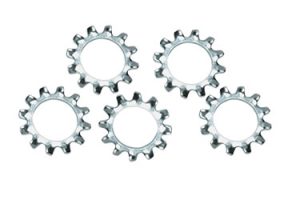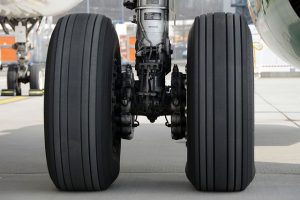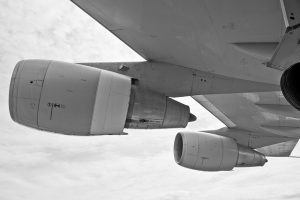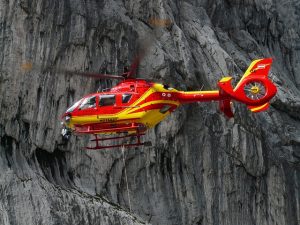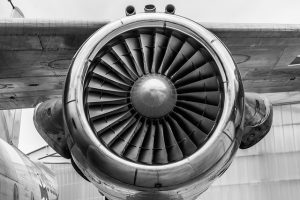
Are you familiar with thrust-to-weight ratio? It’s commonly used in the aviation industry. Commercial airlines must consider their airplanes’ thrust-to-weight ratio. Among other things, it will affect an airplane’s ability to take off, climb and maneuver. What is thrust-to-weight ratio exactly, and why is it important?
Overview of Thrust-to-Weight Ratio
Thrust-to-weight ratio is a ratio of the amount of thrust an airplane produces relative to the airplane’s weight. It uses a simple formula consisting of the airplane’s thrust divided by the airplane’s weight.
Airplanes have engines that produce thrust. Some of them have turbojet engines, whereas others have turboprop or turboshaft engines. Regardless, as the engines burn fuel, they will produce thrust that propels the airplane forward
The weight of an airplane, of course, represents the airplane’s mass influenced by Earth’s gravity. Some airplanes are heavier than others. A typical Boeing 747 weighs over 300,000 pounds. Thrust-to-weight ratio is a ratio of an airplane’s thrust relative to its weight.
Modern-day jet airplanes may have a thrust-to-weight ratio of five. Thrust and weight are both measured in pounds. Therefore, a thrust-to-weight ratio of five means the airplane produces five pounds of thrust for every one pound it weighs.
Why Thrust-to-Weight Ratio Is Important
Thrust-to-weight ratio is important for several reasons. It will affect the airplane’s ability to take off, for instance. The higher the airplane’s thrust-to-weight ratio, the easier it will be for the airplane to take off. A high thrust-to-weight ratio allows airplanes to take off from shorter runways.
Thrust-to-weight ratio plays a key role in the maneuverability of airplanes. Airplanes with a high thrust-to-weight ratio benefit from improved maneuverability. They can perform rolls and other stunts — maneuvers that aren’t possible with a low thrust-to-weight ratio.
Another reason thrust-to-weight ratio is important involves fuel efficiency. Commercial airlines must consider their airplanes’ thrust-to-weight ratio so that they’ll know how much fuel they will consume. A balanced thrust-to-weight ratio that’s not too high nor too low will allow for more fuel-efficient flights.
The Rise of Electric and Hybrid Engines
As new engine technologies emerge, thrust-to-weight ratios will change. In the past, engines have relied on combustion engines. They work by burning fuel, as well as air, inside of a combustion chamber. While most modern-day airplanes continue to use combustion engines, there are electric and hybrid engines being developed.
Electric engines run entirely on electricity, whereas hybrid engines use a combination of fuel and electricity. Because they produce different amounts of thrust compared to traditional combustion engines, they will affect the airplane’s thrust-to-weight ratio.
- SEO Powered Content & PR Distribution. Get Amplified Today.
- PlatoData.Network Vertical Generative Ai. Empower Yourself. Access Here.
- PlatoAiStream. Web3 Intelligence. Knowledge Amplified. Access Here.
- PlatoESG. Automotive / EVs, Carbon, CleanTech, Energy, Environment, Solar, Waste Management. Access Here.
- PlatoHealth. Biotech and Clinical Trials Intelligence. Access Here.
- ChartPrime. Elevate your Trading Game with ChartPrime. Access Here.
- BlockOffsets. Modernizing Environmental Offset Ownership. Access Here.
- Source: https://monroeaerospace.com/blog/what-is-thrust-to-weight-ratio-and-why-is-it-important/
- :is
- :not
- 000
- 200
- 300
- a
- ability
- affect
- AIR
- Airlines
- Airplane
- Airplanes
- allow
- allows
- among
- amount
- amounts
- an
- and
- ARE
- AS
- aviation
- BE
- because
- being
- benefit
- Boeing
- both
- burn
- burning
- by
- CAN
- Chamber
- change
- climb
- combination
- commercial
- commonly
- compared
- Consider
- Consisting
- consume
- continue
- course
- developed
- different
- divided
- easier
- efficiency
- Electric
- electricity
- emerge
- Engine
- Engines
- entirely
- Every
- exactly
- familiar
- five
- Flights
- For
- formula
- from
- Fuel
- fuel efficiency
- gravity
- Have
- High
- higher
- How
- HTTPS
- Hybrid
- important
- improved
- in
- industry
- influenced
- inside
- instance
- IT
- ITS
- jpg
- Key
- Know
- Low
- Mass
- max-width
- May..
- means
- measured
- more
- most
- much
- must
- New
- nor
- of
- off
- on
- ONE
- or
- Other
- Others
- over
- past
- perform
- plato
- Plato Data Intelligence
- PlatoData
- plays
- possible
- pound
- pounds
- produce
- produces
- ratio
- reason
- reasons
- Regardless
- relative
- represents
- Rise
- Role
- rolls
- Run
- several
- Simple
- So
- some
- Take
- Technologies
- than
- that
- The
- their
- Them
- There.
- therefore
- they
- things
- thrust
- to
- too
- traditional
- typical
- use
- used
- uses
- weighs
- weight
- WELL
- What
- What is
- whereas
- while
- why
- will
- with
- Work
- you
- zephyrnet


